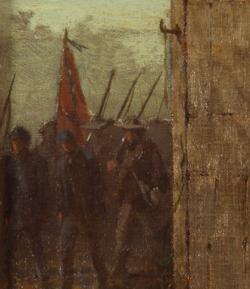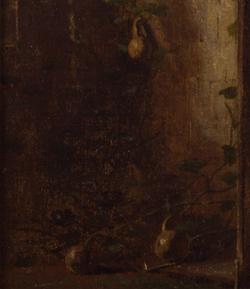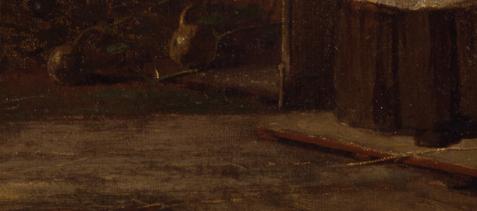Essential questions
• After viewing this work, what would you say the artist wants you to think about or feel?
• How does this art work show the impact of the war on an individual?
• How did the war effect people differently, based on their particular circumstances?

Captured blue-clad Union soldiers being led off to Andersonville prison by their captors. The gray-clad and heavily armed Confederate soldiers.

Drinking gourds were used as a standard symbol of the ‘big dipper’- the constellation that led runaways to the North Star and freedom.

The pathway in front of the female subject is forked suggesting the new choices she has to consider for her future.
Further about the painting
The Confederate Prison Camp in Andersonville is where nearly 13,000 Union prisoners of war died of malnutrition and disease. Located in southeastern Georgia, it served as the main Confederate Prison Camp from February 1864 to the fall of that same year, which allows us to put an approximate date on the painting's time period, as captured Union soldiers are seen marching in the background. Peter Wood in his recently published book, Near Andersonville (Harvard University Press, 2010), a complete study of the painting, tells us that the painting was created by Homer as he pondered the devastating failure of a major Union cavalry engagement known as “Stoneman’s Raid” in July 1864.
The young woman’s African-style scarf underscores her “Africanness” and connects one visually with the red fabric of the Confederate flag in the background – inspiring the viewer to consider the opposing cultures. The woman’s pensive expression also encourages the viewer to ponder her fate.
The Artist
Winslow Homer (born 1836 Boston, Massachusetts- died 1910, Prout’s Neck, Maine)
Homer is considered by art historians one of the most powerful and expressive artists of late 19th century American art. He excelled equally in the arts of illustration, oil painting and watercolor. Homer had a reputation for realism and many of his works dealt with the theme of man’s efforts to establish humanness in the face of an indifferent universe.
At the outbreak of the Civil War, Homer was sent by Harper’s Weekly to draw pictures of battlefield scenes. Many of his other works, especially those depictions of children at play and in school, of farm girls attending to their work, hunters and their prey, have become classic images of 19th-century American life. He is also credited with creating some of the first serious portrayals of African-Americans in American Art.
Winslow Homer was a northerner, specifically from Massachusetts. There is nothing in his biography that suggests he was a strong abolitionist or had strong political feelings on any subject. His most famous works are landscapes and marine topics, so one might assume that he was not trying to convey any particular message in this work. Homer’s work during the war as an illustrator resulted in many drawings, which were not converted into paintings until many years later. Near Andersonville was completed after the war, but was based on his wartime experiences. Since the war had ended by the time is painting this important work, it must be asked: Why did he pick this topic?
Science Connection
The Big Dipper is a well-known group of stars in the northern sky. Its bright stars are easy to find and have been used to help people find the direction north by using the North Star. The seven stars of the Big Dipper are part of the constellation Ursa Major (The Great Bear).
You can find the North Star by drawing a straight line through the front two stars of the Dipper’s bowl. Following this line will lead you directly to the North Star. The North Star located in the handle of the Little Dipper (Ursa Minor or the Little Bear).
The Dipper has a spoon or ladle shape. Since many people in the rural South used hollow gourds as dippers, the Big Dipper is also known as the Drinking Gourd.
According to folklore, escaped slaves traveling along the Underground Railroad used the Drinking Gourd to find their way north to freedom.




